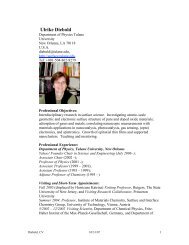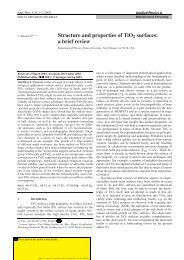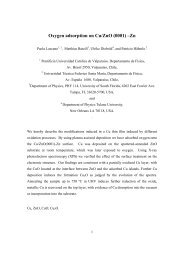The surface science of titanium dioxide - Niser
The surface science of titanium dioxide - Niser
The surface science of titanium dioxide - Niser
Create successful ePaper yourself
Turn your PDF publications into a flip-book with our unique Google optimized e-Paper software.
80 U. Diebold / Surface Science Reports 48 (2003) 53±229<br />
Fig. 13. Ball-and-stick model <strong>of</strong> two terraces <strong>of</strong> TiO 2 (1 1 0). Small black balls represent Ti atoms and large white balls<br />
represent oxygen atoms. <strong>The</strong> step edge FG runs parallel to h1 11i-type directions. <strong>The</strong> smooth and rugged step edges along<br />
h0 01i in Fig. 12 are attributed to step edges AB and HI, respectively. From [116].<br />
that contains several step edges [116]. As outlined above (Section 2.2.1.1) the same number <strong>of</strong> O ! Ti<br />
bonds and Ti ! O bonds need to be broken when cutting a TiO 2 crystal, for example, by forming a step<br />
edge byremoving part <strong>of</strong> the upper terrace. A h1 11i step edge (parallel to the diagonal <strong>of</strong> the <strong>surface</strong> unit<br />
cell) runs between the corners labeled F and G. For clarity, the bonds along this step edge are shaded with<br />
graycolor. <strong>The</strong> orientation <strong>of</strong> the step plane is …1 15†. <strong>The</strong> O atoms along the h1 11i step edge in Fig. 13<br />
are alternatelythreefold (as in the bulk) and tw<strong>of</strong>old coordinated. Formation <strong>of</strong> the step edge creates<br />
fourfold coordinated Ti atoms (terminating the Ti rows <strong>of</strong> the upper terrace) and ®vefold coordinated Ti<br />
atoms (terminating the bridging O rows). It should be pointed out that either these fourfold coordinated Ti<br />
atoms have a formal oxidation state <strong>of</strong> ‡4, or their concentration is verylow, because photoemission<br />
results <strong>of</strong> `unreduced' <strong>surface</strong>s show no evidence <strong>of</strong> Ti 3‡ .<br />
A change in step orientation from the h1 11i to the h1 1 1i direction occurs always at the bridging<br />
oxygen rows (K in Fig. 12). <strong>The</strong> local environment <strong>of</strong> the atoms at such a kink site is not different from<br />
the rest <strong>of</strong> the step edge. Similarlyconstructed models <strong>of</strong> step edges oriented along ‰1 12Š and ‰1 15Š<br />
directions are given in [124].<br />
<strong>The</strong>re are several possibilities to form step edges parallel to the h0 01i direction. One can either cut<br />
next to the Ti atoms underneath the bridging oxygens (parallel to the arrow labeled 1 on the upper<br />
terrace in Fig. 13) or between the in-plane oxygen and <strong>titanium</strong> atoms (parallel to arrow 2). If one cuts<br />
at position 1, an autocompensated step edge is formed: for each Ti ! O bond that is broken in the<br />
upper plane, one O ! Ti bond is broken between the newlyformed bridging oxygens <strong>of</strong> the lower<br />
plane and the ®vefold coordinated <strong>titanium</strong>s <strong>of</strong> the upper plane. Note that there are two different<br />
terminations for such a step edge; the terrace maybe terminated either bya row containing in-plane<br />
oxygen atoms (step edge DC in Fig. 13) or bya row <strong>of</strong> bridging oxygens (step edge AB). Because <strong>of</strong><br />
the observed contrast at step edges (smooth step edges terminate with a dark row, Fig. 12), a<br />
termination with bridging oxygen atoms (step AB in Fig. 13) is favored. (Fischer et al. [117] have<br />
presented a model for a h0 01i step terminating in in-plane oxygen rows. However, these authors<br />
adapted a different interpretation <strong>of</strong> the bright rows in STM as being caused bybridging oxygen rows.)<br />
If one cuts a terrace parallel to the h001i direction at position 2, the step edge that is formed is not<br />
autocompensated: onlyoxygen ! <strong>titanium</strong> bonds are broken on both the upper and on the lower







